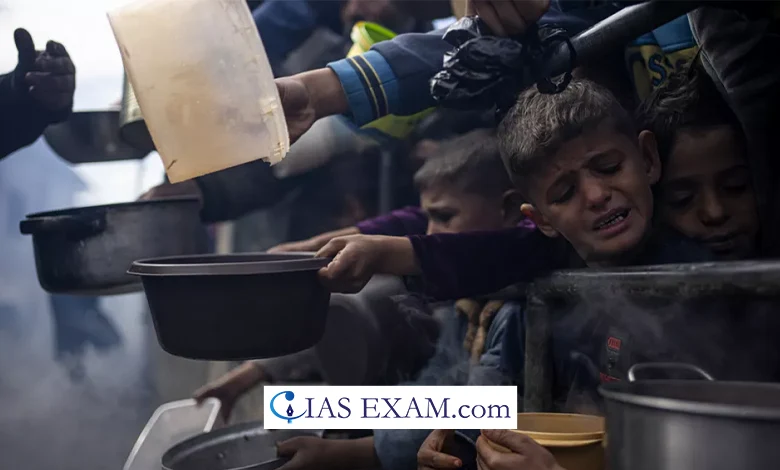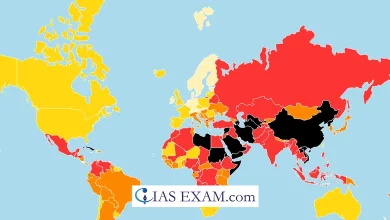Global Report on Food Crises (GRFC)
Syllabus: Food Security [GS Paper-2]

Context
The Global Report on Food Crises (GRFC) for 2023 paints a stark picture of the prevailing food insecurity across the world. With nearly 282 million people in 59 countries and territories experiencing high levels of acute hunger, the urgency to address this issue has never been more critical.
Magnitude of Food Crises
- High Levels of Acute Hunger: The GRFC highlights a significant increase of 24 million people facing acute hunger compared to the previous year. This alarming trend underscores the severity of the global food crisis and the need for immediate action.
- Persistent Acute Food Insecurity: For four consecutive years, the proportion of people facing acute food insecurity has remained persistently high at almost 22 percent. This sustained level of crisis exceeds pre-COVID-19 levels, indicating a deep-rooted problem that requires comprehensive solutions.
- Vulnerability of Children and Women: The report reveals that over 36 million children under 5 years old are acutely malnourished across 32 countries. Furthermore, acute malnutrition has worsened in 2023, particularly among populations displaced by conflict and disasters.
Persistent Hunger and Protracted Crises
- Continued Food Crises: The Global Report on Food Crisis (GRFC) analyses a total number of thirty-six countries since 2016 and these are the countries that constantly feature on the report showing continued years of acute hunger. They are the 80 of the world’s most hungry countries, which is an indication that the crises are sustained.
- Increasing Emergency Situations: It has been reported that there has been a notable raise of 1 million people in IPC/CH Phase 4 food security (acute food insecurity emergency) across the 39 countries and territories. Sudan faced the largest erosion, which directly related to conflict, that 8.6 million people currently face higher levels of acute food insecurity than was observed in 2022.
Catastrophic Levels of Food Insecurity
- Unprecedented Starvation Risk: According to the GRFC in 2023, over 705,000 people are at the level of food insecurity (IPC/CH Phase 5) which is the largest number of people to be food insecure ever to be carried by the GRFC. Consequently such a frightening situation emphasises a call to act to put off the imminent death of these individuals.
- Regional Hotspots: It was revealed that these regions of Gaza Strip, South Sudan, Burkina Faso, Somalia, and Mali appear to be at the highest risk for rapid emergence of famine. It is the Gaza Strip that concentrates on 80% of the world’s population who are about to face disaster. As the crisis becomes severe in many regions, Gaza shines as the problem in this area.
Drivers of Food Crises
- Conflict and Insecurity: Escalating conflict, which is aggravating more than 20 nations, continues to undermine the lives of more than 135 million people. Sudan endured the widest drop as a result mainly of long-lasting wars and thus manifesting the extreme impact that armed conflicts have on food security.
- Extreme Weather Events: There have been 18 countries where a staggering 77 million people were given the red alert and were already facing hunger problems because of extreme weather conditions. Due to the warm summer of 2020, the year 2023 was the hottest on record, and as a result, even more torrential rains, hurricanes, droughts, wildfires, and pest outbreaks occurred.
- Economic Shocks: Economic shocks primarily affected 21 countries, where around 75 million people faced high levels of acute food insecurity. Dependency on imported food and agricultural inputs, coupled with macroeconomic challenges, contributed to this vulnerability.
Breaking the Cycle of Food Crises
- Transformation of Food Systems: Urgent long-term investment is required to transform food systems and boost agricultural and rural development. By addressing underlying structural issues, such as food systems fragility and rural marginalisation, countries can build resilience against future crises.
- Peacebuilding and Conflict Prevention: Peace and prevention must become integral parts of longer-term solutions to food insecurity. By addressing root causes of conflict and promoting peacebuilding efforts, countries can create stable environments conducive to food security.
- Enhanced Crisis Preparedness: Greater crisis preparedness, including early warning systems and rapid response mechanisms, is essential to mitigate the impact of food crises. By investing in preparedness measures, countries can reduce the severity and duration of crises.
- International Cooperation and Support: The international community must prioritise global cooperation and support to address food crises effectively. This includes equitable global economic governance, government-led plans to reduce hunger, and leveraging global initiatives to ensure impactful interventions.
Conclusion
The findings of the Global Report on Food Crises highlight the urgent need for coordinated action to address the growing threat of acute hunger worldwide. By understanding the drivers of food crises and implementing comprehensive solutions, governments and international organisations can work together to break the cycle of hunger and build more resilient and food-secure societies.
Source: FAO
UPSC Mains Practice Question
Q. Discuss the key findings and implications of the Global Report on Food Crises (GRFC) for addressing acute hunger and food insecurity worldwide. What are the underlying drivers of food crises highlighted in the report, and what strategies can be adopted to mitigate the impact of these crises on vulnerable populations?





.png)



